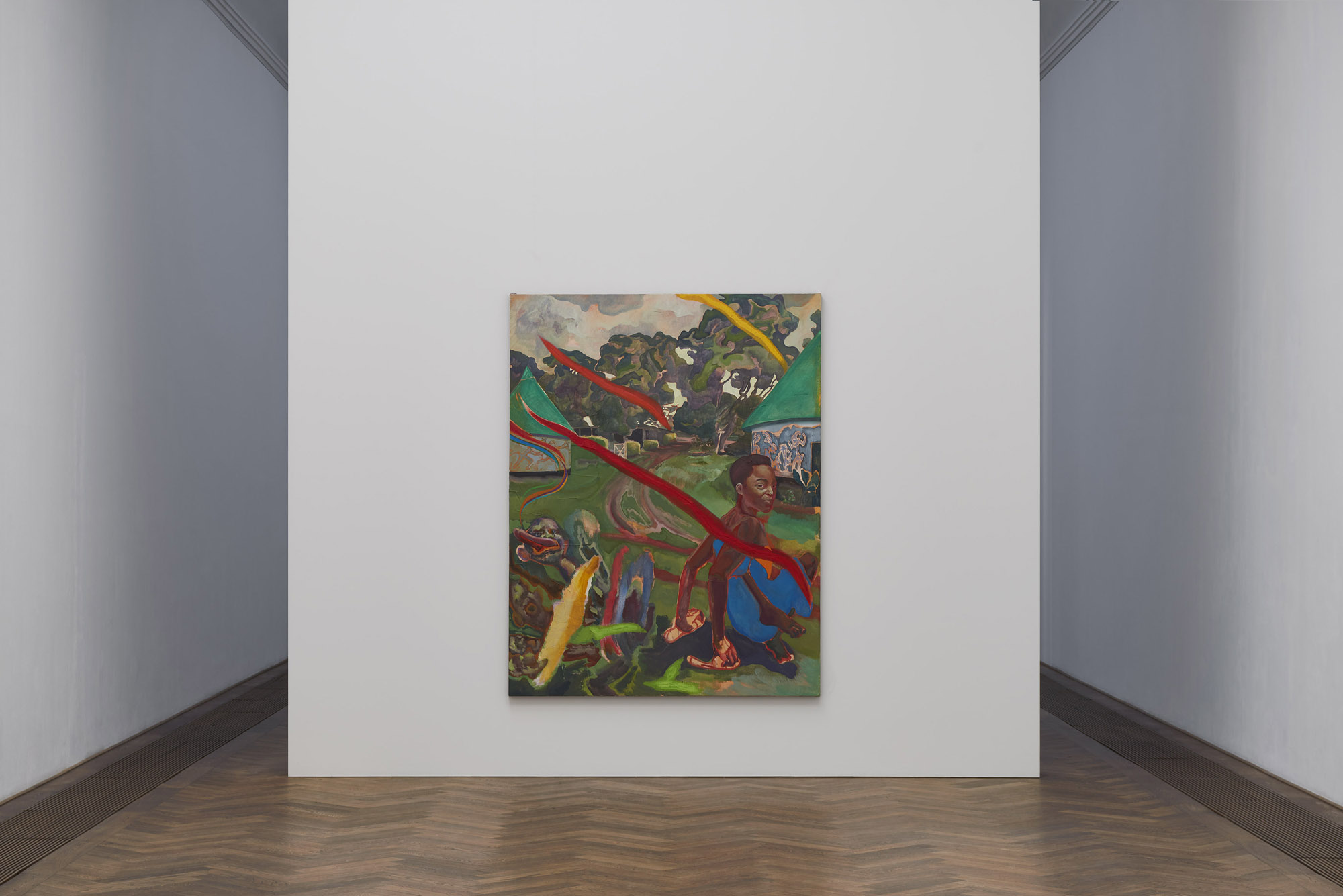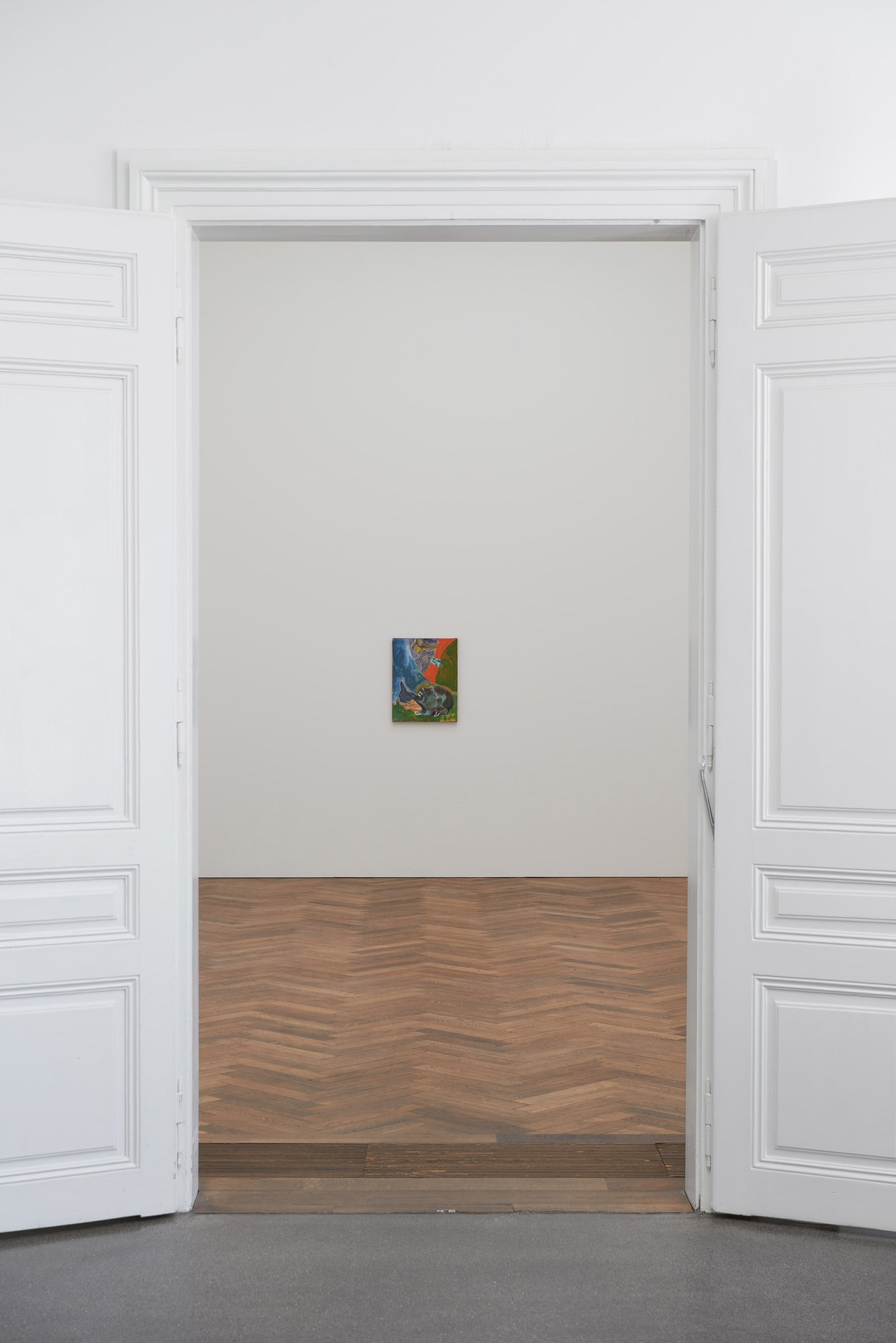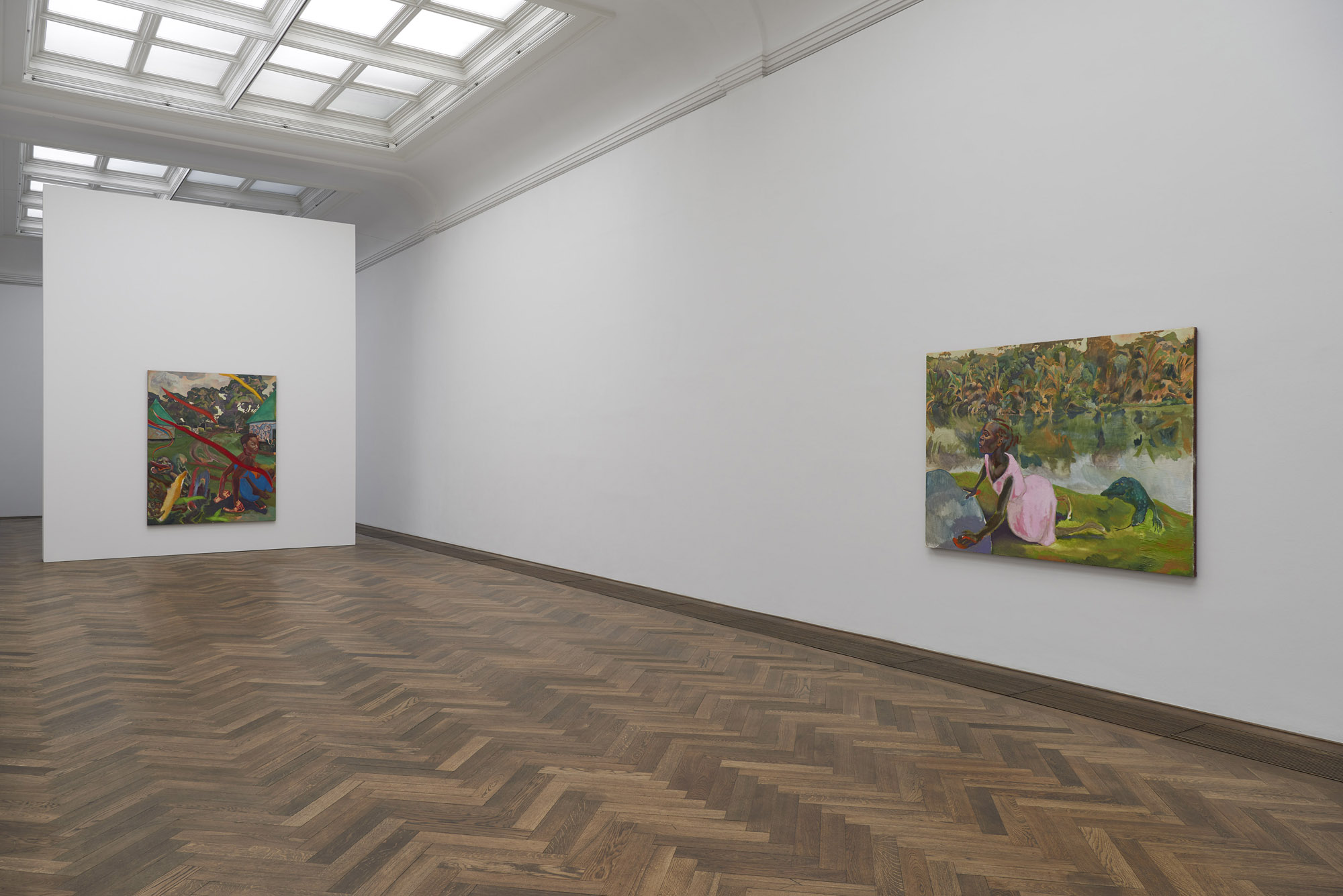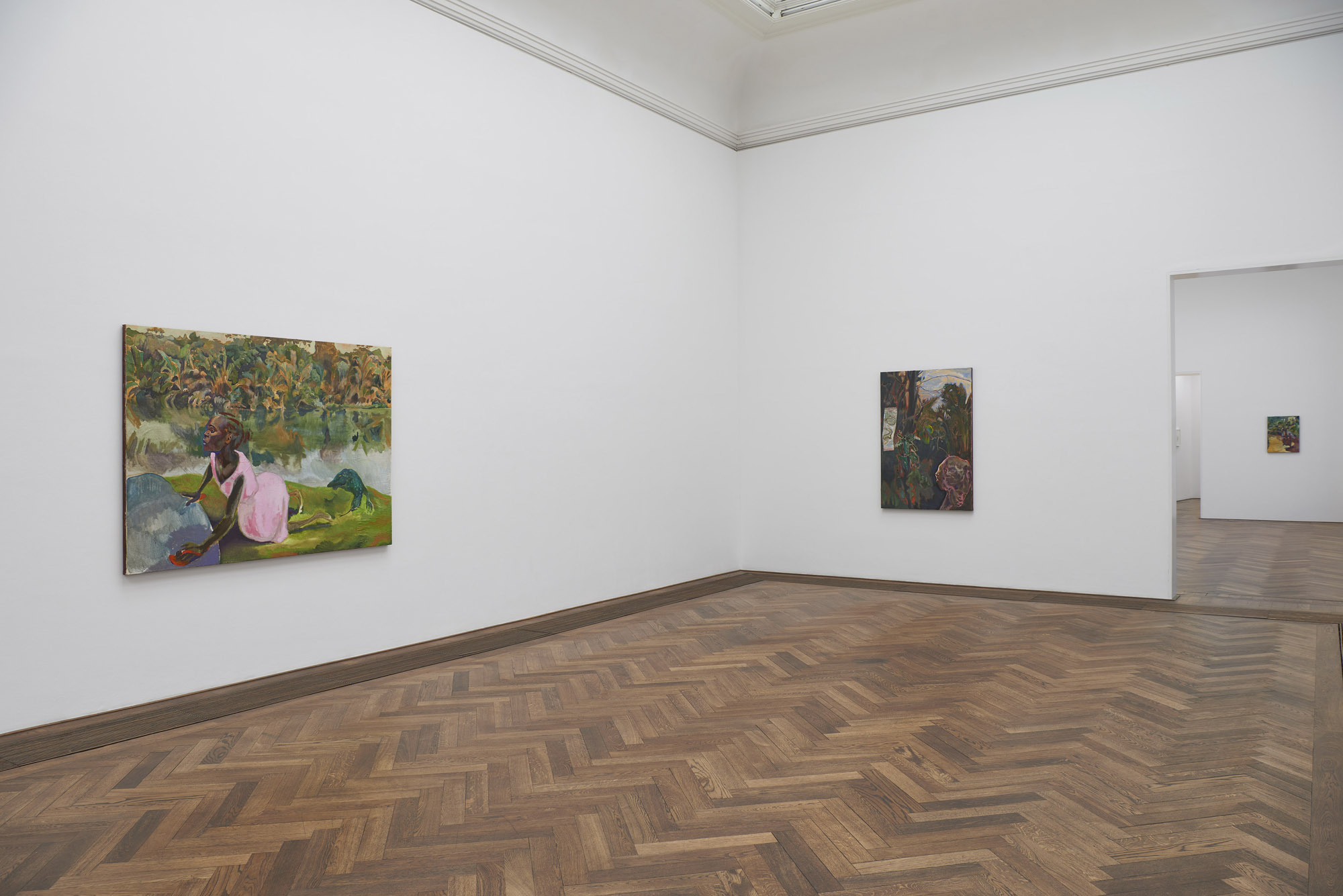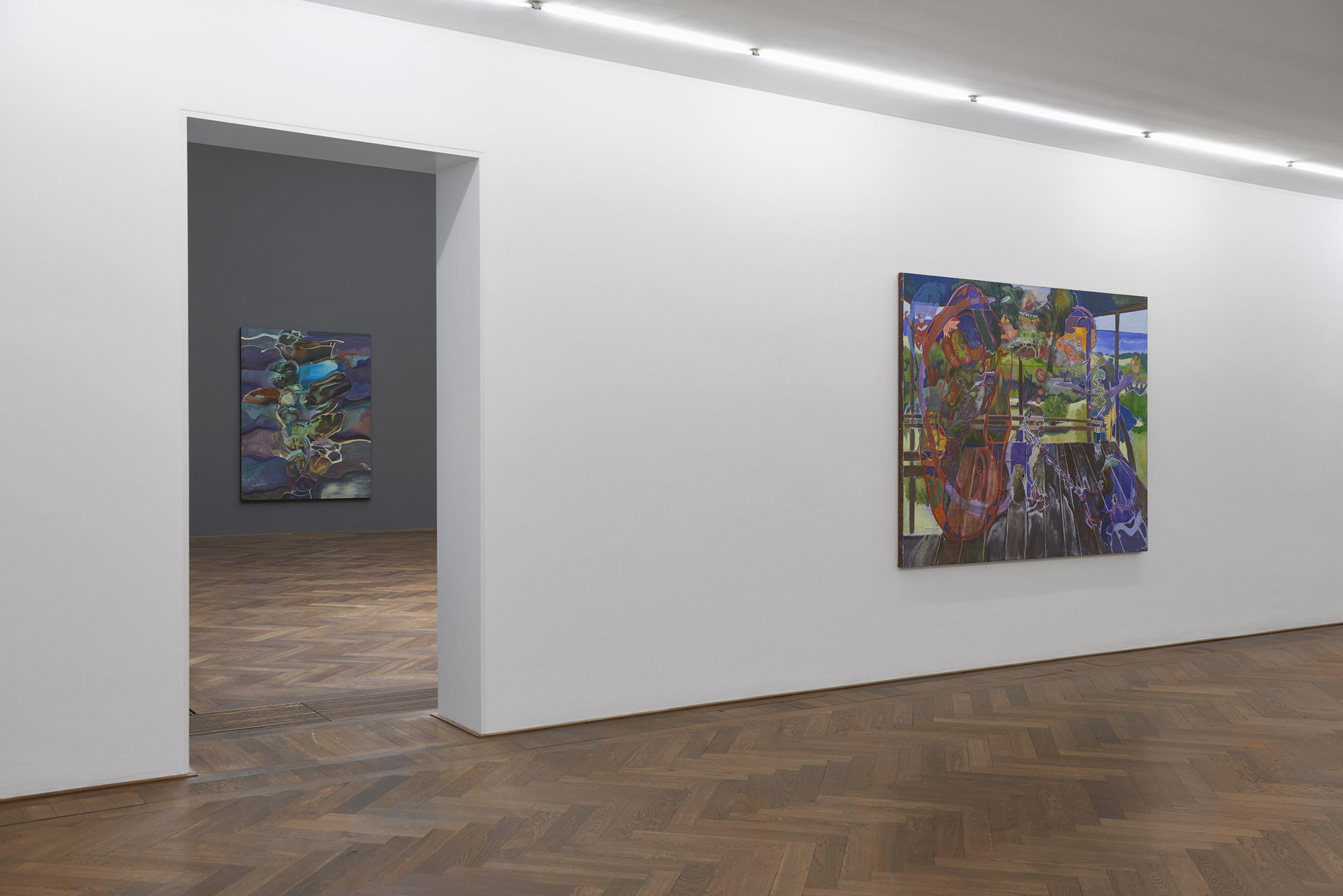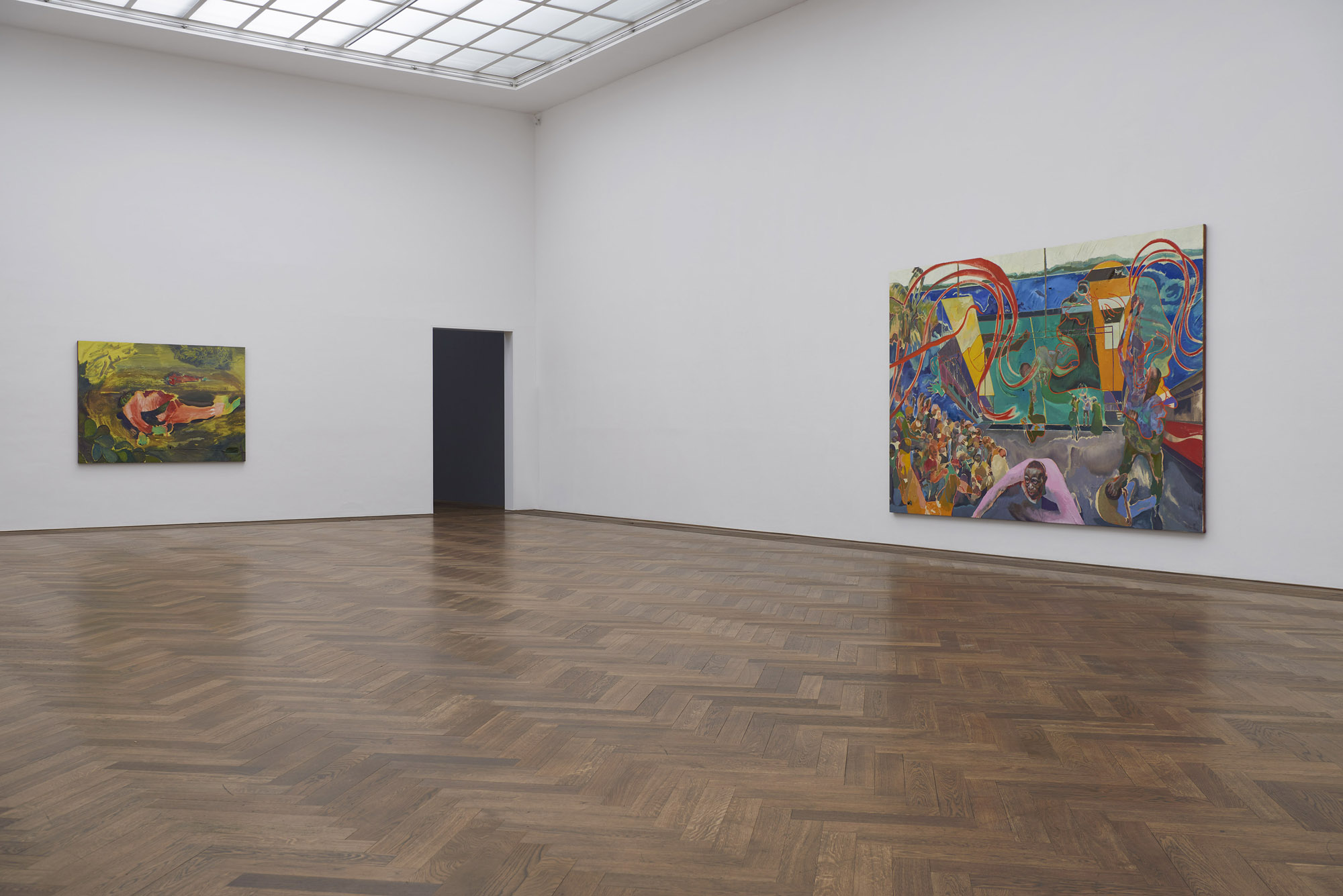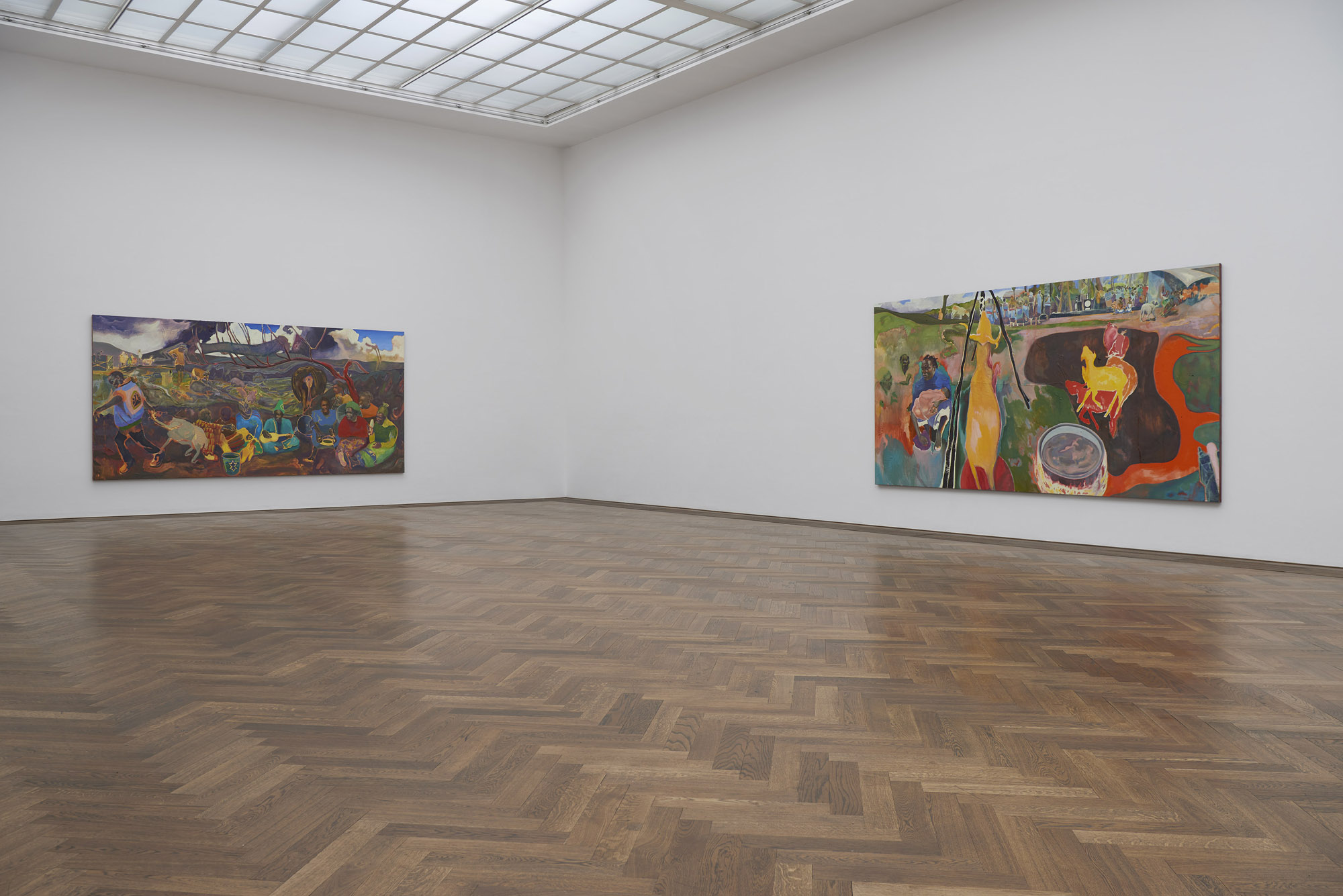Artist: Michael Armitage
Exhibition title: You, Who Are Still Alive
Venue: Kunsthalle Basel, Basel, Switzerland
Date: May 20 – September 4, 2022
Photography: images courtesy the artist and Kunsthalle Basel
Note the velvet lushness, the peculiar atmospheres, and the multiple, sometimes contradictory, perspectives. Note the highly textured surfaces from which emanates an unearthly glow, wrought from the layering of sumptuous but hard-to-name hues (salmon pink beneath a powdery purple-green, for example, might be one possible approximation). Note how viridian forest landscapes meet East African urban life; how recent events tangle with myth; how a 1970s Senegalese film, just like a street conversation, or a news story, or a music video, can inspire a depiction. Note the way the transparency of a face rendered in outline can call into question everything it is surrounded by. Note, as well, the sort of space and time travel that these images consistently perform. Note, perhaps most significantly, the singular aliveness that issues from this Kenyan-British artist’s paintbrush, turning fantastical juxtapositions into hauntingly incandescent paintings.
These qualities are evident in the surreality of a face that doubles and floats above itself, posing the irresolvable question of whether it pictures death, a dream, a traumatic memory, or some liminal space in between (You, Who Are Still Alive, 2022). They are present in the portrayal of Warigia, the legendary tenth daughter of the East African Gĩkũyũ people’s founding father; she is crawling across a grassy knoll, thongs on her hands as if they were feet, with a giant lizard nipping at her heels (Warigia, 2022). They show themselves in the depiction of young boys, high as kites on sniffed glue, their meticulously contoured faces giving way to ethereal mists, each of which then—gorgeously, inexplicably—forms into a flamingo (Three Boys at Dawn, 2022). They emanate from representations of animals, slaughtered and sacrificed, their shapes turning into pure color (Amongst the Living, 2022). And they are palpable in the image of a head that lies, ever so still, on a patch of grass, cleanly severed from its body (Head of Koitalel, 2021). The latter motif is based on the 1905 decapitation of the East African Nandi people’s supreme political and spiritual leader, Koitalel Arap Samoei, who had, while alive, successfully thwarted the British colonialist railway expansion across Nandi territory. But the Brits tricked and brutally killed him, and then took off with his head, claiming ever since at every request for its return that it had been lost. How does one lose such a macabre trophy? The rendition is one of the smallest paintings in the exhibition, a bit larger than head-sized, and eerily serene; one spies a man in the background (the guard meant to watch the head or perhaps the perpetrator himself?) washing up in a nearby river: colonial beheading, it seems, is a dirty business.
Through his compositions, Michael Armitage addresses wildly diverse themes—from tribal founding myths to everyday heroisms and from abuses of power to celebratory rituals—each circulating between past and present, historical fact and conjured fiction. Born in Nairobi, in 1984, Armitage received his artistic training in London. He now lives and works between the two cities, acknowledging each as formative to his creative practice. The artist often researches and records life across Kenya— making sketches, taking informal photographs or videos—in order to carry back these impressions and work them into his paintings in London. Except, that is, where nature is involved: starting with this body of work, he employed the technique of plein air painting when turning his attention to the landscapes of Kenya—in a manner similar to how Impressionists once captured the particular way in which afternoon sunlight may have hit a hay-stack or a group of bathers resting near a pond. Armitage’s painterly style draws from a variety of art histories and eras (from Francisco Goya, Édouard Manet, Paul Gauguin, and Sigmar Polke as much as Iba N’Diaye, Jak Katarikawe, Peter Mulindwa, Chelenge Van Rampelberg, and Meek Gichugu). The substrate on which he chooses to paint, however, is an explicit nod to his African heritage. This ground doggedly subverts Western artistic traditions of which he has such ready command. Nearly from the start of his practice, the artist has consistently substituted canvas with Lubugo, a cloth he first encountered in a Nairobi tourist market. Sourced from a fig tree, the material undergoes a labor-intensive process: below the rough outer skin of the tree, an inner layer of bark is peeled off, singed with banana leaves, soaked, softened by the blows of mallets, dried, and stitched together, its irregular pieces revealing visible tears and pits in their uneven surfaces. The artist’s choice of material is, literally, foundational: traditionally used in Ugandan ritual contexts, Lubugo, which translates as “funeral cloth,” ensures an evocation of death, and along with it of love and loss, that buck-les beneath each otherwise vibrantly painted surface.
Notwithstanding all of the works’ stunning re-presentational power, it is the holes that prevail in Armitage’s paintings. They ensnare you. Each such hole is somehow a wound, but also an aperture, an orifice, a portal. There is a galaxy of them, surrounded by patently stitched joints and thick sutures, raised like keloid scars across a body. This, along with the paintings’ puckering, all the more evocative of damaged and hastily repaired skin, prevents any sense of serenity or ease on the part of a viewer. The holes and tears complicate the image, at times interrupting it; at others, they are its determining aspect. These gaps are as much visual as visceral, throbbing through and against the painted image. In the quivering surfaces, the artist doubles down on the anxiety inherent in his narratives.
One senses it, spectacularly, in this exhibition. You, Who Are Still Alive features an impressive new body of works, painted over the past three years for this Kunsthalle Basel show, the artist’s most comprehensive presentation of recent work to date. It includes numerous large-scale paintings, among them the largest Armitage has ever made, and a selection of delicate ink drawings that reveal his exquisite draftsmanship. Time is a mash-up in his hands; one finds exposed flesh, fetid jungles, piglets that suckle from dangling human breasts, burn-ing cauldrons, and beasts of burden roaming the land, but also nylon tracksuits, the swish of a Coca-Cola logo, and a PA system. These remind you that Armitage may be a magic realist, but he paints in order to speak to and of the present. And although in his paintings one might sense a latent threat of violence or evocations of human weakness, the gentleness with which a closed-eyed figure is rendered as if caressed or the way in which a beast’s laughably distended pink anus is made to correspond with an actual hole in the painting’s surface testify to the painter’s generosity, humor, and levity. His is an art of celebration and irrefutable compassion as much as it is one of dire warnings. To fail to notice this would be to miss one of the central stakes of Armitage’s project. Because you—dear viewer, steward of the planet’s future—are still alive, and this work incites you to live radiantly, to love indiscriminately, to remember your fore-bearers, and maybe to even right a few past wrongs.
Michael Armitage was born in 1984 in Nairobi; he lives and works in London and Nairobi.
Installation view, Michael Armitage, You, Who Are Still Alive, Kunsthalle Basel, 2022, view on, Head of Koitalel, 2021. Photo: Philipp Hänger / Kunsthalle Basel
Installation view, Michael Armitage, You, Who Are Still Alive, Kunsthalle Basel, 2022, view on, The Perfect Nine, 2022. Photo: Philipp Hänger / Kunsthalle Basel
Kunsthalle Basel Installation view, Michael Armitage, You, Who Are Still Alive, Kunsthalle Basel, 2022, view (f. l. t. r.) on, Personal Thoughts (Asshole), 2021; The Perfect Nine, 2022; Warigia, 2022. Photo: Philipp Hänger / Kunsthalle Basel
Installation view, Michael Armitage, You, Who Are Still Alive, Kunsthalle Basel, 2022, view (f. l. t. r.) on, The Perfect Nine, 2022, and, Warigia, 2022. Photo: Philipp Hänger / Kunsthalle Basel
Kunsthalle Basel Installation view, Michael Armitage, You, Who Are Still Alive, Kunsthalle Basel, 2022, view (f. l. t. r.) on, Warigia, 2022; Account of an Illiterate Man, 2020; Homecoming, 2021. Photo: Philipp Hänger / Kunsthalle Basel
Installation view, Michael Armitage, You, Who Are Still Alive, Kunsthalle Basel, 2022, view (f. l. t. r.) on, Mother’s Milk, 2022, and, Homecoming, 2021. Photo: Philipp Hänger / Kunsthalle Basel
Installation view, Michael Armitage, You, Who Are Still Alive, Kunsthalle Basel, 2022, view on, Mother’s Milk, 2022. Photo: Philipp Hänger / Kunsthalle Basel
Installation view, Michael Armitage, You, Who Are Still Alive, Kunsthalle Basel, 2022, view (f. l. t. r.) on, Witness, 2022; Cave, 2021; Forest, 2022. Photo: Philipp Hänger / Kunsthalle Basel
Installation view, Michael Armitage, You, Who Are Still Alive, Kunsthalle Basel, 2022, view (f. l. t. r.) on, Holding Cell, 2021, and, Witness, 2022. Photo: Philipp Hänger / Kunsthalle Basel
Installation view, Michael Armitage, You, Who Are Still Alive, Kunsthalle Basel, 2022, view on, You, Who Are Still Alive, 2022. Photo: Philipp Hänger / Kunsthalle Basel
Installation view, Michael Armitage, You, Who Are Still Alive, Kunsthalle Basel, 2022, view (f. l. t. r.) on, Three Boys at Dawn, 2022, and, Holding Cell, 2021. Photo: Philipp Hänger / Kunsthalle Basel
Kunsthalle Basel Installation view, Michael Armitage, You, Who Are Still Alive, Kunsthalle Basel, 2022, view (f. l. t. r.) on, Ciru (Kericho January 2008), 2022, and, You, Who Are Still Alive, 2022. Photo: Philipp Hänger / Kunsthalle Basel
Installation view, Michael Armitage, You, Who Are Still Alive, Kunsthalle Basel, 2022, view (f. l. t. r.) on, Dead Soldiers, 2022, and, Curfew (Likoni March 27, 2020), 2022. Photo: Philipp Hänger / Kunsthalle Basel
Kunsthalle Basel Installation view, Michael Armitage, You, Who Are Still Alive, Kunsthalle Basel, 2022, view (f. l. t. r.) on, Dandora (Xala, Musicians), 2022, and, Amongst the Living, 2022. Photo: Philipp Hänger / Kunsthalle Basel
Installation view, Michael Armitage, You, Who Are Still Alive, Kunsthalle Basel, 2022, view on, Curfew (Likoni March 27, 2020), 2022. Photo: Philipp Hänger / Kunsthalle Basel

